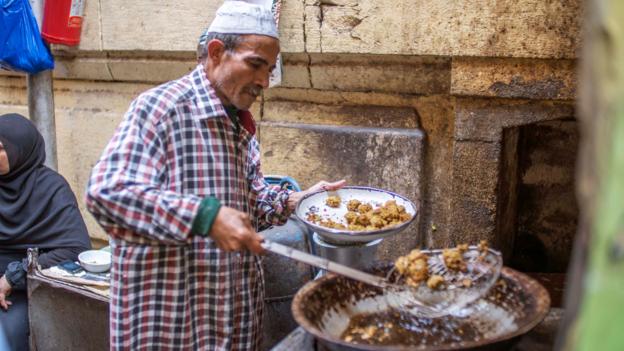It’s Wednesday afternoon in downtown Cairo, and the usual smorgasbord of humanity is going about its daily business. From sharp-suited businesspeople single-mindedly weaving through the capital’s notorious traffic to young men on bicycles perching wooden trays of fresh bread on their heads. Everyone, it seems, has somewhere to be.
Down a small alleyway in the Abdeen neighbourhood, I marvel at the graceful, 19th- to 20th-Century Belle Époque stylings of a faded apartment building, the intricate balconies and wooden shutters offering a glimpse of life in this teeming city many decades ago.
Opposite sits a small, metal food cart. A counter runs around it, offering somewhere for patrons to hurriedly eat their meal, and tins of corned beef – used in sandwiches or mixed with eggs – are stacked with care and uniformity on the top shelf. Below are eggs, metal pots, bags of the nation’s much-loved aish baladi (a type of whole-wheat flatbread) and a few plates containing taameya, Egypt’s glorious, but underappreciated, version of falafel. Many food lovers rate it as the best falafel in the world.
You may also be interested in:
• Who invented hummus?
• The chefs reinventing Palestinian cuisine
• Israel’s millennia-old ‘biblical diet’
The cart’s owner, Amir, smiles beneath his greying moustache as he works. He removes taameya mix from a large metal bowl, forms it into small discs using his fingertips and drops them into boiling oil. His hands are almost a blur; each disc takes about a second to make.
A few minutes later I’m presented with the finished article: piping hot taameya served inside aish baladi with nothing more than tomatoes, lettuce and a drizzle of tahini. On the side sit crunchy pickled vegetables in a riot of colours – the highlight of which is whole green chillies caked in chilli powder, cumin and salt. The medium-hot chilli adds a welcome bite to proceedings, yet is offset by the bitter nuttiness of the attendant cumin.
The taameya sandwich is a lesson in perfect simplicity
The taameya sandwich is a lesson in perfect simplicity. Nearby countries such as Syria and Lebanon have a reputation for incorporating greater flair into their falafel sandwiches, experimenting with different fillings and sauces, such as coleslaw, tomato herb salad and pickled turnips. These no doubt have their place but, in my opinion, they’d be hard-pressed to beat the Egyptian version. In fact, falafel cooked by Egyptian fast-casual chain Zööba won ‘best falafel’ at 2016’s London Falafel Festival in Borough Market, beating Palestinian-Lebanese competitors and leading to more ‘best in the world’ talk.
Much of that is thanks to a certain idiosyncrasy in the way Egyptians make their falafel. Gone are the chickpeas so ubiquitous in most other countries; here, the main ingredient is broad beans, which fry better and result in a lighter, fluffier take on the popular snack. Along with garlic, onion and coriander seeds, the Egyptian mix also incorporates a greater number of fresh herbs and vegetables – such as parsley, coriander and leeks – than its neighbours’, producing a pale green interior and greater depth of flavour.
“I totally agree that the best falafel in the world comes from Egypt, and I’ve certainly told people who went to Egypt that,” said Claudia Roden, the famed culinary anthropologist and serial Middle Eastern cookbook author. “It’s all down to the taste and texture. I think broad beans… have a better texture than chickpeas, because they’re softer and creamier, plus the Egyptian version has more herbs, which makes it greener. I think the overall flavouring is much better.”
The Egyptian love affair with broad beans – also known as fava beans – runs deep. Along with taameya and bread, the country’s other staple dish is ful medames, in which broad beans are stewed for more than 12 hours and mixed with garlic, olive oil, cumin and lemon juice. Taameya and ful medames are primarily breakfast dishes, though their unswerving popularity means they are often consumed at any time of day.
In his book, Beans: A History, food historian Ken Albala writes that eating broad beans in Egypt “seems to be a conscious act of nationalism. Ful medames is an expression of identity for modern Egyptians who choose to resist the onslaught of contemporary breakfast foods; it is a way to remember who they are.”
Exactly when and why the broad bean took hold in Egypt, while most of its neighbours became enamoured with the chickpea, remains something of a mystery.
Both ingredients feature in a medieval Egyptian cookbook titled Treasure Trove of Benefits and Variety at the Table: A Fourteenth-Century Egyptian Cookbook, though the chickpea surprisingly features in more recipes.
Nawal Nasrallah, the researcher and food writer who translated the book into English, speculates that this is due to chickpeas being considered a higher-class ingredient at that time. Broad beans were seen as a poor man’s food, and, in medieval times as today, cookbook authors would have wanted to show off their most elegant dishes.
Although both ingredients do feature in most regional cuisines, she said that Egypt’s subsequent embrace of broad beans over chickpeas could simply be down to availability.
“I think it depends on what you have and what grows abundantly… I think chickpeas are more abundant in the Levant, which why they use them. Whereas from ancient times, broad beans were used more in northern Africa… It’s all about economics. It’s cheap, it’s available. In fact, they say that broad beans are ‘the kebab of the poor’.”
This link to ancient Egypt is regularly cited as key to the broad bean’s enduring popularity in the country. Everyday Egyptians will trumpet ful medames and taameya as ‘the food of the pharaohs’ – there are widely cited records of broad bean traces being found in ancient tombs and claims that paintings from ancient Egyptian times show people cooking taameya.
However, Mennat-Allah El Dorry, an Egyptologist and archaeobotanist at the University of Warsaw in Poland, has serious doubts about these assertions. She believes the broad beans found at ancient Egyptian sites were most likely modern contaminations; that the workmen on site at the excavations, some of which took place 100 years ago when methodologies were less stringent, could well have been eating ful medames and the beans found their way into the archaeological sites.
Eating broad beans in Egypt seems to be a conscious act of nationalism
“Then, later, they come find it again and think: ‘Oh, good, we have ancient Egyptian ful’,” she said. “I think it wasn’t until Roman times that it started becoming more common… By the Roman times you start to get broad beans much more commonly on archaeological sites and, as time goes by, by medieval Egypt, you have broad beans appearing archaeobotanically much more often.”
The beans have also been found in places that don’t make sense, such as a fifth-dynasty (2465-2325 BCE) royal funerary setting in Abu Sir on the outskirts of Cairo. “There is absolutely no reason for broad beans to be there – it’s not a settlement context and it’s not a funerary food offering, so I’m very doubtful of the finds of broad beans in ancient Egypt,” El Dorry said.
As for the ancient paintings, scholars have since questioned the original publication and say the ‘broad beans’ depicted were more likely to have been tiger nuts, also known as chufa, a tuber that is believed to have been a staple in ancient Egypt.
What is in less doubt is the ferocity of the debate over the origins – and mastery – of falafel. Lebanon, the Palestinian Territories, Syria and Egypt have all claimed to be its rightful ‘home’, while Israel has labelled it a national dish and firmly bound it to the country’s national identity.
In her book, Falafel Nation: Cuisine and the Making of National Identity in Israel, Yael Raviv writes that “Food is constantly implicated in economic and political processes, as well as in social and historical processes… Because of the recent events in the Middle East, even something as innocent looking as a ground chickpea ball can be used as a weapon of sorts.”
Standing at his food cart in a green football shirt under a blue Nike jacket, Amir gesticulates enthusiastically when discussing his country’s take on falafel. He’s been serving it the Egyptian way for 48 years, he said.
“People who try the Egyptian style made with [broad] beans always like the taste, but those who eat it with hommos [chickpeas] just have to get used to it. Since the pharaonic times, we have been planting [broad] beans, not hommos,” he said, once again espousing the possibly misguided belief that broad beans have been eaten here since ancient Egyptian times.
While there’s debate as to the origins of broad beans, most modern historians tend to agree that falafel was indeed likely born in Egypt. It has been traced to the country’s Coptic Christians, who used it to replace meat during Lent. Such dishes were known as ‘muzawwarat’, which means ‘counterfeit dishes’, because they did not contain meat.
While Nasrallah agrees falafel is likely to have originated in Egypt, she feels the whole discussion has become too politicised.
I don’t think dishes can be owned
“I don’t tend to think of food in this narrow, nationalistic way,” she said. “Of course, the Israelis adopted it as one of the national dishes, but I don’t think dishes can be owned… I think food belongs to a region.”
Most would agree that food is far too subjective for definitives like ‘best in the world’, but the brisk business being done by hundreds of taameya vendors all over Cairo testifies that Egyptians are in little doubt over the eminence of their broad bean-based formula. And as I bit through the doughy aish baladi bread to discover the toothsome crunch within, I found it hard to disagree.
Culinary Roots is a series from BBC Travel connecting to the rare and local foods woven into a place’s heritage.
Join more than three million BBC Travel fans by liking us on Facebook, or follow us on Twitter and Instagram.
If you liked this story, sign up for the weekly bbc.com features newsletter called “The Essential List”. A handpicked selection of stories from BBC Future, Culture, Capital and Travel, delivered to your inbox every Friday.

















